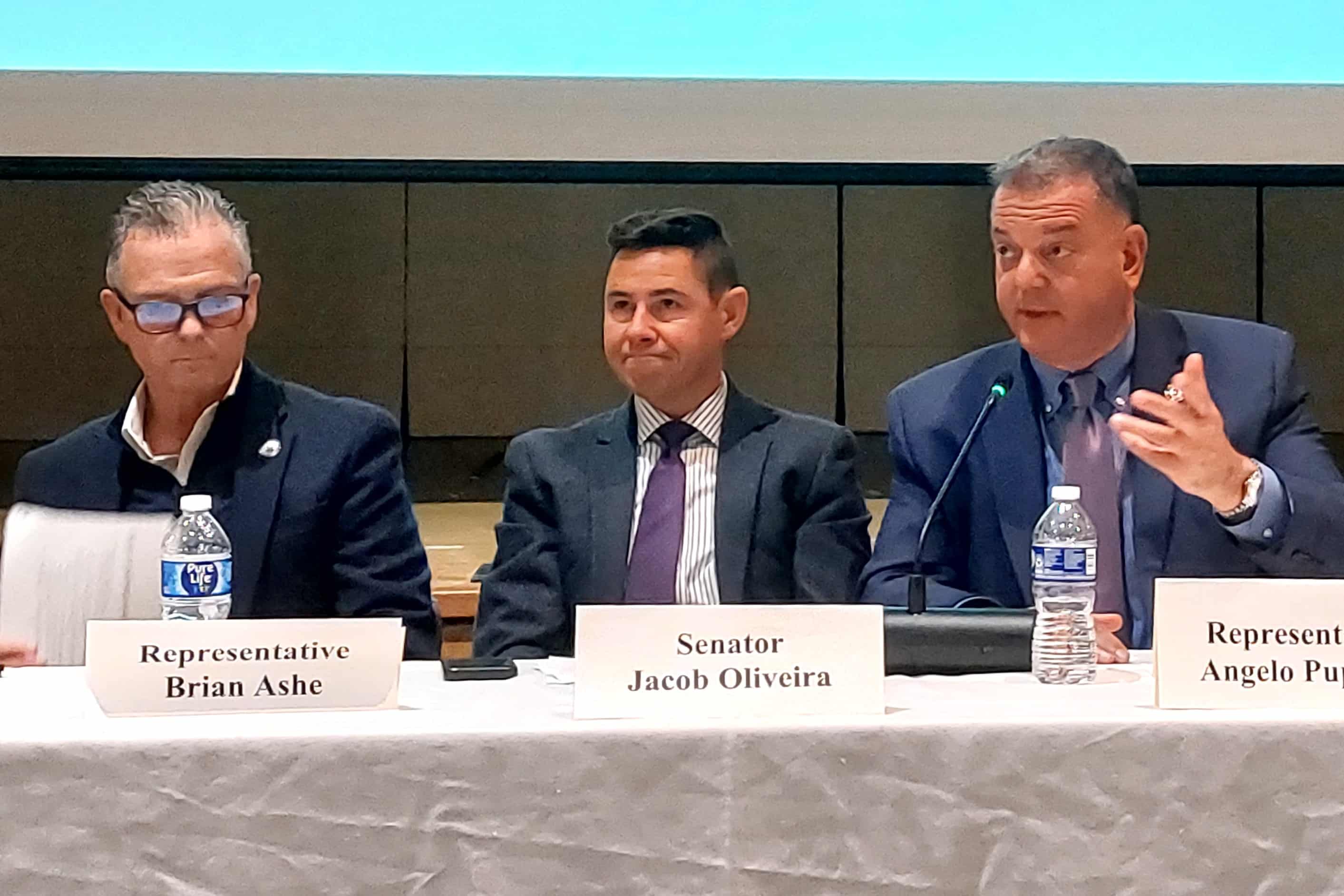State Sen. Jacob Oliveira and state Reps. Angelo Puppolo and Brian Ashe respond to the concerns of the Hampden-Wilbraham regional School District and town leadership.
Reminder Publishing photo by Sarah Heinonen
WILBRAHAM — Each year, when putting together a budget, the Hampden-Wilbraham Regional School Committee invites leadership from both towns and the state legislators who represent them to a budget roundtable.
In Massachusetts, the state budget is passed after the required deadlines for municipal budgets. As such, the towns and school districts create budgets with the latest estimates of expected state funding. The roundtable is Hampden and Wilbraham’s effort to plead their case for more funding to the legislators.
Before the meeting began in earnest, a handful of educators and members of the Hampden-Wilbraham Education Association addressed the panel of officials. They spoke about being forced to take on second jobs to make ends meet and not having the needed support and supplies for their classrooms, “We fund what we value,” said HWEA member Christine Goonan.
Budget
Assistant Superintendent for Finance, Operations & Human Resources Douglas Slaughter presented the district’s proposed fiscal year 2026 budget based, in part, on the funding levels spelled out in Gov. Maura Healey’s draft of the state budget.
The total budget is $40.84 million, $1.83 million, or 4.7%, over FY25’s budget.
A school district’s budget is composed of a few components. The state determines a district’s foundation budget, which is the amount of funding needed to provide the students with a basic education. The foundation budget is composed of two pieces: the minimum local contribution — what the state decides the municipalities can pay based, in large part, on its tax revenue — and Chapter 70 state aid. The budget will often also include additional municipal funding and other aid and grant funding.
Slaughter said the governor’s proposed budget allocated to HWRSD the minimum increase in Chapter 70 aid allowed — $75 per student. Because of that, he said, “More burden is placed on the communities to carry the cost of school.”
Federal funding is “significantly” lower this year, as the Elementary and Secondary School Emergency Relief grants have expired. There are also substantial reductions to the Title I and Title IIA funding sources due to changes in the towns’ demographics. He also pointed out that the state funding for the METCO program, in which students from cities, such as Springfield, can opt to attend school in nearby districts, was cut 63.8% from the current fiscal year due to a funding formula change.
An unknown factor in setting the budget this year is the fact that the contracts for all union employees are up for negotiation. The guaranteed step increases were included in the budget preparations, but a cost-of-living adjustment is not. He estimated a 1% COLA for all union members would cost the district about $325,000. Other costs factored into the budget include estimated increases of $200,000 and $42,000 for retirement benefits and health insurance costs, respectively.
When reviewing the resources available, Slaughter said $1 million from the district’s Excess and Deficiency account, which acts similar to a savings account, is available as a one-time funding source to help offset the FY26 budget. Additionally, a shortage of bus drivers has created a need for the district to switch from a two-tier system to three tiers. Slaughter said he has not yet received the FY26 assessment from the Lower Pioneer Valley Educational Collaborative, which supplies district’s buses, but the change will lower the assessment as it will require fewer buses.
Beyond the operational budget, the district is also facing capital expenses. Slaughter explained that the district is in the process of creating a 10-year plan to prioritize and schedule the big-ticket items that the schools must repair or replace in the foreseeable future. Projects that affect the schools’ safety and security are the most pressing, but the logistical feasibility of projects is also a consideration.
Some projects may be eligible for funding through the Massachusetts School Building Authority, a semi-autonomous entity that helps districts with the cost of school buildings and repairs. “We have some needs” that may be eligible for the MSBA’s Accelerated Repair Program, Slaughter said. Although he noted that the program would only be accepting projects every other year in the future, the district will submit applications when possible.
Project 232
Superintendent John Provost returned attention to the minimum Chapter 70 funding proposed for HWRSD. He said that districts in Western Massachusetts have often seen lower amounts of Chapter 70 funding than their counterparts in the eastern part of the state, often with the explanation that the area receives less resources because there are fewer people in the western part of the state. This year, however, 232 of the state’s 319 school districts are also receiving the minimum amount.
Considering that three-quarters of the state’s public school districts were slated to receive the minimum increase to Chapter 70 funds, Provost asked, “Is this the time where there can be some change?”
Provost called the need to address the issue, “Project 232.” He laid out three options for addressing the issue — factor higher costs when setting the foundation budget, adjust the target aid share or change the split between the state and local funding. There are three bills before the state Legislature that Provost urged the lawmakers to consider: An act to ensure adequate and equitable funding for public education, an act increasing the commonwealth’s share of the education foundation budget and an act changing regional school transportation reimbursement law.
Toward the beginning of the meeting, Provost had pointed out the achievement of several students and groups within the district. He said that all but one of the district’s 28 athletic teams qualified for the post season, 20 students were named to the University of Massachusetts Amherst High School Honor Band and student Aby Haile was elected to become the first Black female president of the Massachusetts Association of School Councils.
At the state level, Provost said Massachusetts students in grades 4 and 8 ranked highest in the country in both math and reading on the 2024 National Assessment of Education Progress. “Our students’ performance places them in the top half or the top state in the nation,” Provost said.
“If we can’t help three-quarters of the districts,” the superintendent said, “you can forget 27 of 28 teams going to the finals, you can forget [20] students being UMass honors students and, most of all, you can forget Massachusetts being number one in the nation.”
Legislators respond
“We get the message,” said state Rep. Angelo Puppolo (D-Wilbraham). He appreciated that there was “concern and love” from the district, the educators and the towns. He said the roundtable is an opportunity to learn more about the needs of the towns and schools. Puppolo acknowledged that regional transportation is not 100% as promised under the law, but he said the legislators work to increase it each year. He assured that the governor’s budget is only a recommendation. He also admitted that the Chapter 70 formula is antiquated and needs to be addressed.
State Rep. Brian Ashe (D-Longmeadow) said, “We work hard to get Chapter 70 better every year, try to get [special education] better, try to get regional transportation.” He said having people affected in other parts of the state will help them understand, “This isn’t just a Western Mass. problem. This is an education problem.” Ashe said, “We will continue to push for better funding. We want to make sure that we continue to turn out the best kids in this state … whether it’s in music, whether it’s in sports, whether it’s in academics.”
State Sen. Jacob Oliveira (D-Ludlow) said, “Chapter 70 is the lifeblood.” He said the Student Opportunity Act was passed in 2018 with “courageous” votes and it has aided the state’s Gateway Cities. However, he shared, “It is not working for school districts in Massachusetts. It is not working for rural school districts or regional school districts in the commonwealth.”
Of the 11 school districts in Oliveira’s district, only Springfield and Chicopee saw sizable increases for this year’s proposed budget, he noted. “We need to blow up the funding formula.” He said efforts to try to do so did not pass last year and cautioned that it may take a couple years to do so. Oliveira said addressing the impacts of inflation on education “is step number one.”
He said state support of school districts will ease the impact on towns and help keep property taxes from spiking. Special education has been hit particularly hard by inflationary pressures, he said, citing the 14% hike in out-of-district tuition that former Gov. Charlie Baker’s administration approved in 2022.
Oliveira drew a line from healthcare costs and federal Medicare dollars to education. The state already pays 55% of its revenue to healthcare programs, he said, and noted that if federal funding is cut, there will be even less for education.
Wilbraham Finance Committee member Joseph Lawless said, “We heard loud and clear from Dr. Provost, the cost of education is going up.”
He said that there is sometimes an impression that “the big, bad finance committee doesn’t want to fund anything,” but “we’re put in … an impossible position.”
He said the town is already hearing from residents that taxes are too high. Alternatively, he said the town would have to cut programs and the budgets of other departments to find the schools. As it is, he said, the school budget is more than some other department budgets “combined.” Aside from these options, he said, the district has to consider cuts.
Hampden Selectboard Chair Donald Davenport said, “From the Selectboard’s perspective, we obviously value education. But we also value public safety, we also value our senior citizens, we also value our police and fire departments. You have to make those judgements. We only have a certain pot of money.”
Hampden Selectboard member John Flynn said that with more districts facing a minimum of Chapter 70, he hopes the pushback “will grow into a movement.” From his perspective, one of the major problems is unfunded state mandates. “The state needs to step up and do their part. We’re not asking for extra money; we’re asking for our money back.”
John Matthews, a member of the Hampden Advisory Committee, said the state has been failing to honor its commitments to regional transportation for more than 50 years. He also said he heard the same comments from legislators last year. The state needs to “step up,” he said. School Committee member Tim Collins suggested suing the state to increase the funding for education.
Wilbraham Select Board Chair Susan Bunnell agreed that the decisions around funding are difficult ones. She said the legislators seemed to be listening more than they have in the past.
Wilbraham Select Board member Michael Squindo urged his colleagues to work to figure out how to fund the $1.8 million more than last year that is needed for a level service budget. While pressuring the state is important, he said that funding the schools “is our burden.”



